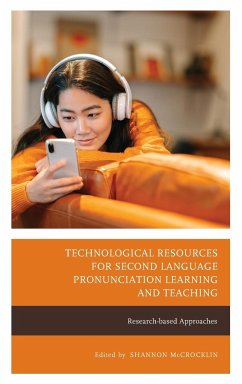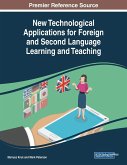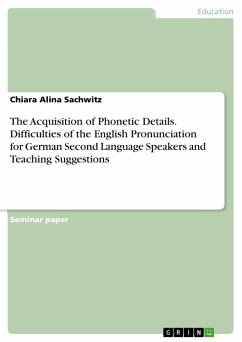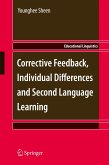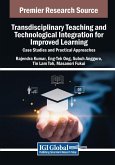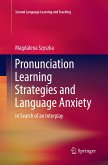Technological Resources for Second Language Pronunciation Learning and Teaching
Research-based Approaches
Herausgeber: McCrocklin, Shannon
Technological Resources for Second Language Pronunciation Learning and Teaching
Research-based Approaches
Herausgeber: McCrocklin, Shannon
- Gebundenes Buch
- Merkliste
- Auf die Merkliste
- Bewerten Bewerten
- Teilen
- Produkt teilen
- Produkterinnerung
- Produkterinnerung
This book introduces research on a wide variety of technologies that can support second language pronunciation learning. While working to introduce practitioners to numerous technologies available, it also dives into the research-basis for their use, providing new studies and data for language-learning contexts.
Andere Kunden interessierten sich auch für
![New Technological Applications for Foreign and Second Language Learning and Teaching New Technological Applications for Foreign and Second Language Learning and Teaching]() New Technological Applications for Foreign and Second Language Learning and Teaching174,99 €
New Technological Applications for Foreign and Second Language Learning and Teaching174,99 €![New Technological Applications for Foreign and Second Language Learning and Teaching New Technological Applications for Foreign and Second Language Learning and Teaching]() New Technological Applications for Foreign and Second Language Learning and Teaching224,99 €
New Technological Applications for Foreign and Second Language Learning and Teaching224,99 €![The Acquisition of Phonetic Details. Difficulties of the English Pronunciation for German Second Language Speakers and Teaching Suggestions The Acquisition of Phonetic Details. Difficulties of the English Pronunciation for German Second Language Speakers and Teaching Suggestions]() Chiara Alina SachwitzThe Acquisition of Phonetic Details. Difficulties of the English Pronunciation for German Second Language Speakers and Teaching Suggestions15,95 €
Chiara Alina SachwitzThe Acquisition of Phonetic Details. Difficulties of the English Pronunciation for German Second Language Speakers and Teaching Suggestions15,95 €![Corrective Feedback, Individual Differences and Second Language Learning Corrective Feedback, Individual Differences and Second Language Learning]() Younghee SheenCorrective Feedback, Individual Differences and Second Language Learning112,99 €
Younghee SheenCorrective Feedback, Individual Differences and Second Language Learning112,99 €![Positive Psychology Perspectives on Foreign Language Learning and Teaching Positive Psychology Perspectives on Foreign Language Learning and Teaching]() Positive Psychology Perspectives on Foreign Language Learning and Teaching104,99 €
Positive Psychology Perspectives on Foreign Language Learning and Teaching104,99 €![Transdisciplinary Teaching and Technological Integration for Improved Learning Transdisciplinary Teaching and Technological Integration for Improved Learning]() Transdisciplinary Teaching and Technological Integration for Improved Learning186,99 €
Transdisciplinary Teaching and Technological Integration for Improved Learning186,99 €![Pronunciation Learning Strategies and Language Anxiety Pronunciation Learning Strategies and Language Anxiety]() Magdalena SzyszkaPronunciation Learning Strategies and Language Anxiety104,99 €
Magdalena SzyszkaPronunciation Learning Strategies and Language Anxiety104,99 €-
-
-
This book introduces research on a wide variety of technologies that can support second language pronunciation learning. While working to introduce practitioners to numerous technologies available, it also dives into the research-basis for their use, providing new studies and data for language-learning contexts.
Hinweis: Dieser Artikel kann nur an eine deutsche Lieferadresse ausgeliefert werden.
Hinweis: Dieser Artikel kann nur an eine deutsche Lieferadresse ausgeliefert werden.
Produktdetails
- Produktdetails
- Verlag: Lexington Books
- Seitenzahl: 352
- Erscheinungstermin: 22. Dezember 2022
- Englisch
- Abmessung: 235mm x 157mm x 25mm
- Gewicht: 722g
- ISBN-13: 9781666902297
- ISBN-10: 1666902292
- Artikelnr.: 65697386
- Herstellerkennzeichnung
- Libri GmbH
- Europaallee 1
- 36244 Bad Hersfeld
- gpsr@libri.de
- Verlag: Lexington Books
- Seitenzahl: 352
- Erscheinungstermin: 22. Dezember 2022
- Englisch
- Abmessung: 235mm x 157mm x 25mm
- Gewicht: 722g
- ISBN-13: 9781666902297
- ISBN-10: 1666902292
- Artikelnr.: 65697386
- Herstellerkennzeichnung
- Libri GmbH
- Europaallee 1
- 36244 Bad Hersfeld
- gpsr@libri.de
Shannon McCrocklin is associate professor of Applied Linguistics/TESOL in the Department of Linguistics at Southern Illinois University.
Part 1: Getting Started with Technology in Second Language Pronunciation
Learning and Teaching
Chapter 1: Exploring Technologies Available for Teaching and Learning
Second Language Pronunciation
Chapter 2: From Technology-enhanced to Technology-based Language Teaching -
A Complexity Theory Approach to Pronunciation Teaching
Part 2: Web-based Resources, Tools, and Language-learning Platforms
Chapter 3: Preparing Second Language Educators to Teach Pronunciation with
Technology
Chapter 4: Designing and Evaluating an e-Teaching Package of English
Phonetics and Pronunciation for Preservice Teachers
Chapter 5: Developing Portuguese Oral Skills Via Instructional Technology
Tools: Students' Views and Recommended Practices
Chapter 6: Performance-based Test: A Technology-based Achievement
Assessment in Introductory Japanese Courses
Part 3: Automatic Speech Recognition
Chapter 7: Transparent Language: Learners' Perceptions, Successes, and
Challenges of Using a Speech Recognition Tool for Molding Beginner Spanish
Pronunciation in Online Courses
Chapter 8: Integrating Mobile-based Text-To-Speech (TTS) and Speech-To-Text
(STT) to Advance Proficiency and Intelligibility in French
Chapter 9: Developing Pronunciation Learner Autonomy with Automatic Speech
Recognition and Shadowing
Chapter 10: Exploring Pronunciation Learning in Simulated Immersive
Language Learning Experiences in Virtual Reality
Part 4: Speech Visualization
Chapter 11: L2 Japanese Vowel Production: A Closer Look at Transfer
Effects From Perception Training with Waveforms
Chapter 12: Speech Visualization for Pronunciation Instruction: Exploring
Instructor Support in L2 Learner Attitudes Towards Visual Feedback
Chapter 13: Vowel Visualization for CAPT: A Learner-input Model for Tool
Development
Part 5: Corpus-based Approaches
Chapter 14: Spoken Corpora in Pronunciation Research and Instruction: The
Case of the Corpus of Teaching Assistant Classroom Speech (CoTACS)
Chapter 15: Innovation in ITA Course Design: Incorporating Student-designed
Field-specific Corpora
Learning and Teaching
Chapter 1: Exploring Technologies Available for Teaching and Learning
Second Language Pronunciation
Chapter 2: From Technology-enhanced to Technology-based Language Teaching -
A Complexity Theory Approach to Pronunciation Teaching
Part 2: Web-based Resources, Tools, and Language-learning Platforms
Chapter 3: Preparing Second Language Educators to Teach Pronunciation with
Technology
Chapter 4: Designing and Evaluating an e-Teaching Package of English
Phonetics and Pronunciation for Preservice Teachers
Chapter 5: Developing Portuguese Oral Skills Via Instructional Technology
Tools: Students' Views and Recommended Practices
Chapter 6: Performance-based Test: A Technology-based Achievement
Assessment in Introductory Japanese Courses
Part 3: Automatic Speech Recognition
Chapter 7: Transparent Language: Learners' Perceptions, Successes, and
Challenges of Using a Speech Recognition Tool for Molding Beginner Spanish
Pronunciation in Online Courses
Chapter 8: Integrating Mobile-based Text-To-Speech (TTS) and Speech-To-Text
(STT) to Advance Proficiency and Intelligibility in French
Chapter 9: Developing Pronunciation Learner Autonomy with Automatic Speech
Recognition and Shadowing
Chapter 10: Exploring Pronunciation Learning in Simulated Immersive
Language Learning Experiences in Virtual Reality
Part 4: Speech Visualization
Chapter 11: L2 Japanese Vowel Production: A Closer Look at Transfer
Effects From Perception Training with Waveforms
Chapter 12: Speech Visualization for Pronunciation Instruction: Exploring
Instructor Support in L2 Learner Attitudes Towards Visual Feedback
Chapter 13: Vowel Visualization for CAPT: A Learner-input Model for Tool
Development
Part 5: Corpus-based Approaches
Chapter 14: Spoken Corpora in Pronunciation Research and Instruction: The
Case of the Corpus of Teaching Assistant Classroom Speech (CoTACS)
Chapter 15: Innovation in ITA Course Design: Incorporating Student-designed
Field-specific Corpora
Part 1: Getting Started with Technology in Second Language Pronunciation
Learning and Teaching
Chapter 1: Exploring Technologies Available for Teaching and Learning
Second Language Pronunciation
Chapter 2: From Technology-enhanced to Technology-based Language Teaching -
A Complexity Theory Approach to Pronunciation Teaching
Part 2: Web-based Resources, Tools, and Language-learning Platforms
Chapter 3: Preparing Second Language Educators to Teach Pronunciation with
Technology
Chapter 4: Designing and Evaluating an e-Teaching Package of English
Phonetics and Pronunciation for Preservice Teachers
Chapter 5: Developing Portuguese Oral Skills Via Instructional Technology
Tools: Students' Views and Recommended Practices
Chapter 6: Performance-based Test: A Technology-based Achievement
Assessment in Introductory Japanese Courses
Part 3: Automatic Speech Recognition
Chapter 7: Transparent Language: Learners' Perceptions, Successes, and
Challenges of Using a Speech Recognition Tool for Molding Beginner Spanish
Pronunciation in Online Courses
Chapter 8: Integrating Mobile-based Text-To-Speech (TTS) and Speech-To-Text
(STT) to Advance Proficiency and Intelligibility in French
Chapter 9: Developing Pronunciation Learner Autonomy with Automatic Speech
Recognition and Shadowing
Chapter 10: Exploring Pronunciation Learning in Simulated Immersive
Language Learning Experiences in Virtual Reality
Part 4: Speech Visualization
Chapter 11: L2 Japanese Vowel Production: A Closer Look at Transfer
Effects From Perception Training with Waveforms
Chapter 12: Speech Visualization for Pronunciation Instruction: Exploring
Instructor Support in L2 Learner Attitudes Towards Visual Feedback
Chapter 13: Vowel Visualization for CAPT: A Learner-input Model for Tool
Development
Part 5: Corpus-based Approaches
Chapter 14: Spoken Corpora in Pronunciation Research and Instruction: The
Case of the Corpus of Teaching Assistant Classroom Speech (CoTACS)
Chapter 15: Innovation in ITA Course Design: Incorporating Student-designed
Field-specific Corpora
Learning and Teaching
Chapter 1: Exploring Technologies Available for Teaching and Learning
Second Language Pronunciation
Chapter 2: From Technology-enhanced to Technology-based Language Teaching -
A Complexity Theory Approach to Pronunciation Teaching
Part 2: Web-based Resources, Tools, and Language-learning Platforms
Chapter 3: Preparing Second Language Educators to Teach Pronunciation with
Technology
Chapter 4: Designing and Evaluating an e-Teaching Package of English
Phonetics and Pronunciation for Preservice Teachers
Chapter 5: Developing Portuguese Oral Skills Via Instructional Technology
Tools: Students' Views and Recommended Practices
Chapter 6: Performance-based Test: A Technology-based Achievement
Assessment in Introductory Japanese Courses
Part 3: Automatic Speech Recognition
Chapter 7: Transparent Language: Learners' Perceptions, Successes, and
Challenges of Using a Speech Recognition Tool for Molding Beginner Spanish
Pronunciation in Online Courses
Chapter 8: Integrating Mobile-based Text-To-Speech (TTS) and Speech-To-Text
(STT) to Advance Proficiency and Intelligibility in French
Chapter 9: Developing Pronunciation Learner Autonomy with Automatic Speech
Recognition and Shadowing
Chapter 10: Exploring Pronunciation Learning in Simulated Immersive
Language Learning Experiences in Virtual Reality
Part 4: Speech Visualization
Chapter 11: L2 Japanese Vowel Production: A Closer Look at Transfer
Effects From Perception Training with Waveforms
Chapter 12: Speech Visualization for Pronunciation Instruction: Exploring
Instructor Support in L2 Learner Attitudes Towards Visual Feedback
Chapter 13: Vowel Visualization for CAPT: A Learner-input Model for Tool
Development
Part 5: Corpus-based Approaches
Chapter 14: Spoken Corpora in Pronunciation Research and Instruction: The
Case of the Corpus of Teaching Assistant Classroom Speech (CoTACS)
Chapter 15: Innovation in ITA Course Design: Incorporating Student-designed
Field-specific Corpora

